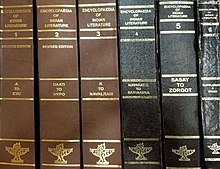Encyclopaedia of Indian Literature
 The six volumes of the encyclopedia | |
| Country | India |
|---|---|
| Language | English |
| Subject | Indian literature and language |
| Publisher | Sahitya Akademi, New Delhi |
Publication date |
|
| Media type | 6 volumes, hardbound |
OCLC | 430192715 |
The Encyclopaedia of Indian Literature is a multi-volume English language encyclopedia of Indian literature published by Sahitya Akademi, India's National Academy of Letters. The idea for the project emerged in the mid-1970s, and three volumes were planned to cover all Indian literature, including that in native vernaculars. The scope of the project expanded as several editors-in-chief succeeded one another; six volumes were published between 1987 and 1993. The work received a positive reception, though a number of critics noted occasional inaccuracies in entries regarding a few of the subjects surveyed in what was otherwise hailed as a landmark in Indian scholarship.
History
At the 1975 annual meeting of the General Council of the
While the compilation of lists of topics was in progress, dissatisfaction with the General Council emerged, and the location of the encyclopaedia unit at Trivandrum was questioned. To resolve the issues, a special meeting of the Executive Board was convened in 1976 to re-examine the project, and the board decided to relocate the encyclopaedia unit to
Publication
The first volume in the series was published in 1987, under the auspices of the then
Datta also edited volumes 2 and 3, published in 1988 and 1989 respectively. He retired from the Akademi on reaching seventy in 1990. Mohan Lal succeeded him as the editor-in-chief and it was under his direction that the fourth and fifth volumes, respectively published in 1991 and 1992, came out. After Lal's death in an accident, the sixth and final volume, edited by Param Abichandani and K. C. Dutt, was published in 1994. K. Ayyappa Paniker was appointed editor-in-chief of revisions.[3][4]
Reception
The first volume, published in 1987, was widely acclaimed.
The reviewer of The Statesman, published on 2 July 1988, thought otherwise:
To mention all instances of carelessness, errors of fact, omissions in the work and its entries will require 100 pages and it will be tiresome reading. On the whole the first volume of our Sahitya Akademi's Encyclopaedia of Indian Literature has been unworthy of the institution which has produced it. It is not well designed and whatever design it may have has not been properly executed... There is nothing in the work to show that it has passed through the hands of an able, responsible and hard-working editor.[3]
In 1990, Vinayak Purohit of the Indian Institute of Social Research, Bombay, appealed to Prime Minister
Defamation suit
Ujjalkumar Majumdar's article on Bengali poet
See also
Notes
Citations
Sources
- Rao, D. S. (2004). Five Decades: The National Academy of Letters, India : a Short History of Sahitya Akademi. New Delhi: Sahitya Akademi. ISBN 978-81-260-2060-7.
